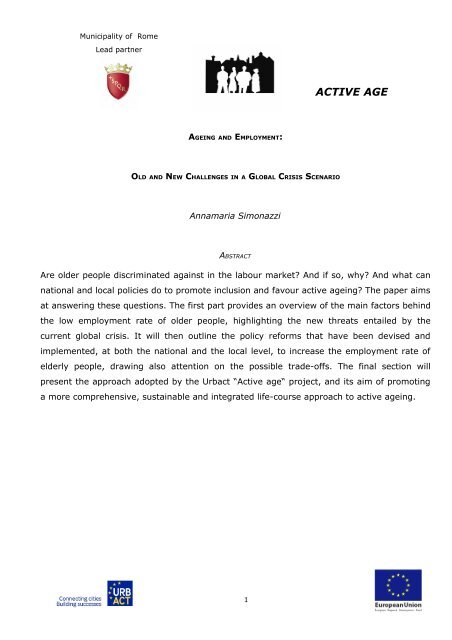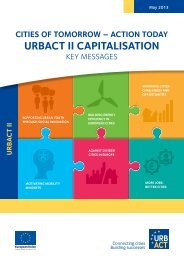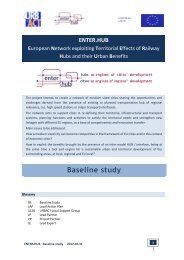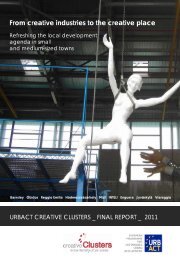ACTIVE AGE - Urbact
ACTIVE AGE - Urbact
ACTIVE AGE - Urbact
Create successful ePaper yourself
Turn your PDF publications into a flip-book with our unique Google optimized e-Paper software.
Municipality of Rome<br />
Lead partner<br />
<strong>AGE</strong>ING AND EMPLOYMENT:<br />
OLD AND NEW CHALLENGES IN A GLOBAL CRISIS SCENARIO<br />
Annamaria Simonazzi<br />
ABSTRACT<br />
<strong>ACTIVE</strong> <strong>AGE</strong><br />
Are older people discriminated against in the labour market? And if so, why? And what can<br />
national and local policies do to promote inclusion and favour active ageing? The paper aims<br />
at answering these questions. The first part provides an overview of the main factors behind<br />
the low employment rate of older people, highlighting the new threats entailed by the<br />
current global crisis. It will then outline the policy reforms that have been devised and<br />
implemented, at both the national and the local level, to increase the employment rate of<br />
elderly people, drawing also attention on the possible trade-offs. The final section will<br />
present the approach adopted by the <strong>Urbact</strong> “Active age“ project, and its aim of promoting<br />
a more comprehensive, sustainable and integrated life-course approach to active ageing.<br />
1
Municipality of Rome<br />
Lead partner<br />
1. Population ageing and employment<br />
<strong>ACTIVE</strong> <strong>AGE</strong><br />
Population ageing is both a challenge and an opportunity. A challenge to the various welfare<br />
regimes, an opportunity to move towards a more comprehensive, sustainable and<br />
integrated life-course approach to active ageing.<br />
Radical changes in the age structure will have significant labour market impacts. Under<br />
present conditions, longer life expectancy leads to a sharp decrease in the<br />
employed/pensioner ratio. However, employment is the principal means by which citizens of<br />
all ages can meet their needs and socioeconomic aspirations. At the same time, a high<br />
employment rate is the only way to secure long-term sustainability for any welfare system.<br />
That is why the EU has set two targets to be met by 2010: to have at least 50% of the EU<br />
population aged 55-64 in employment (defined in the Stockholm European Council in 2001)<br />
and to raise by 5 years the effective average age at which people stop working (agreed in<br />
the 2002 Barcelona European Council).<br />
If older workers remain in employment longer and increase their labour supply, the demand<br />
for these workers will need to keep up. To ensure that demand meets supply, the Member<br />
States should pursue actions aiming at removing disincentives at the micro-level - for<br />
workers to retire later and for employers to hire and retain older workers -, as well as at the<br />
macro-level.<br />
In many countries, the lack of job opportunities remains a problem cutting across<br />
generations due to structural features of the economy: policies designed to extend working<br />
lives are more likely to affect the younger generations’ prospects (young in - old out, or<br />
viceversa). The current economic crisis has sharpened the risk of crowding out, making of<br />
stagnating demand the main challenge faced by European labour markets. Macroeconomic<br />
policies should ensure that total labour demand is such as to prevent inter-generational<br />
competition for jobs.<br />
2
Municipality of Rome<br />
Lead partner<br />
<strong>ACTIVE</strong> <strong>AGE</strong><br />
Local labour market policies targeting individuals (active labour market policies) must not<br />
be implemented in isolation: they should take into consideration the possible effects on<br />
other generations, and be complemented by labour market reforms aiming at increasing<br />
demand.<br />
This paper focuses on active age and employment. Section 2 provides an overview of the<br />
main factors behind the low employment rate of older people and whether and why older<br />
people are discriminated against in the labour market; and section 3 outlines the policy<br />
reforms that have been devised and implemented, at both the national and the local level,<br />
to increase the employment rate of elderly people, highlighting the possible trade-offs. The<br />
final section will present the approach adopted by the <strong>Urbact</strong> “Active age“ project.<br />
2. The age divide<br />
On average, the employment rate of people aged 55-64 is half that of the prime working<br />
age (25-54). With few notable exceptions, the European countries are still far from the<br />
Stockholm objective (figure 1). Gender is one single important factor in cross-country<br />
differences: in a number of countries, women have a much lower participation rate at all<br />
ages, and a more discontinuous working career. (However, due to economic and social<br />
change, inactivity rates have been rising for men and decreasing for women.) Although 65<br />
is the official age of retirement in most countries, the main reason for inactivity among 55-<br />
64-year-olds is retirement. Once again, gender matters, since personal or family<br />
responsibilities which hardly make any showing among the reasons for men’s inactivity loom<br />
large for women. Dismissal or redundancy (9.5% of all reasons) and own illness or disability<br />
(11.5%) come after retirement (46%) and early retirement (19.2%) as the main reasons<br />
for older workers aged 55-64 to leave their jobs or businesses.<br />
3
Municipality of Rome<br />
Lead partner<br />
Fig. 1 - Employment rates across EU Member States for older workers (55-64) by gender,<br />
2008<br />
United Kingdom<br />
Sweden<br />
Finland<br />
Slovakia<br />
Slovenia<br />
Romania<br />
P ortugal<br />
P oland<br />
Austria<br />
Netherlands<br />
Malta<br />
Hungary<br />
Lithuania<br />
Latvia<br />
Cyprus<br />
Italy<br />
France<br />
Spain<br />
Greece<br />
Ireland<br />
Estonia<br />
Germany (including ex-GDR from 1991)<br />
Denmark<br />
Czech Republic<br />
Bulgaria<br />
Belgium<br />
European Union (15 countries)<br />
European Union (27 countries)<br />
Source: Eurostat, EU LFS, 2008<br />
<strong>ACTIVE</strong> <strong>AGE</strong><br />
0,0 10,0 20,0 30,0 40,0 50,0 60,0 70,0 80,0<br />
Female Male T ot<br />
2010 Stockholm target<br />
Early retirement can cover up discriminatory practices (Casey and Laczko 1989). Lack of<br />
incentives on the part of employers to hire older workers (the demand side), and lack of<br />
incentives – indeed, often, disincentives – for older workers to remain at work (supply side)<br />
4
Municipality of Rome<br />
Lead partner<br />
<strong>ACTIVE</strong> <strong>AGE</strong><br />
are the main reasons for the low employment rate of mature workers. To increase this rate<br />
thus means addressing the factors affecting the problematic transitions in a working career<br />
- financial disincentives, employers’ attitudes, and attractiveness of work - in order to<br />
ensure employability, continuity of employment, and re-entry.<br />
Policy disincentives. Research by the OECD (2005) suggests that there are, embedded in<br />
public policies, strong disincentives to remain in the labour market on ageing. High<br />
replacement rates may negatively affect the attractiveness of working longer. 1 Early<br />
retirement institutions may also negatively affect elderly participation in more indirect<br />
ways: by negatively affecting the expected return to training, generous (as opposed to<br />
flexible) early retirement schemes may discourage training participation by older workers<br />
(Fouarge and Schils 2009). Pension reforms have been carried out in many member states<br />
with the primary aim of increasing the retirement age (and/or tightening conditions and<br />
reducing entitlements by switching to funded schemes). A number of countries are<br />
introducing more flexibility in the age of retirement and in the possibility to combine<br />
pensions and earnings.<br />
Age-related discrimination. Employers seem to prefer investing in young workers, whose<br />
longer time horizon allows the firm to recover the cost of new technologies (Langot and<br />
Moreno-Galbis 2008: 26). Stereotypes and prejudice may affect both employers’<br />
willingness to hire and elderly workers’ self-confidence, and hence their active search for a<br />
new job in case of redundancy (O’Cinneide 2005; Gosheh Jr. et al 2006).<br />
More expensive. Elderly workers are generally considered to be more expensive and less<br />
productive. Seniority-based wage systems can entail increasing labour costs at older ages<br />
(OECD 2006). More flexible pay systems (and in particular moving away from seniority-<br />
based wage systems) might enhance the job security and employability of older workers by<br />
1 The OECD study finds a strong negative correlation between employment rates of workers aged 55-64 and<br />
the replacement rate (that is, the ratio of annual benefits to earnings before retirement), with Mediterranean<br />
countries at the higher end.<br />
5
Municipality of Rome<br />
Lead partner<br />
<strong>ACTIVE</strong> <strong>AGE</strong><br />
reducing their relative cost. 2 The EC thus seems to advocate finally bringing in more<br />
flexibility throughout the whole life-cycle. One should, however, consider the negative<br />
income effects of these reforms, whose effects may be aggravated by more precarious<br />
working careers during the life cycle.<br />
Less productive? Empirical research indicates that productivity increases with age;<br />
supervisors, conversely, point to a negative relation (Taylor 2001). Experience, stability and<br />
reliability seem to go under-rated, as is the possibility to reduce depletion or obsolescence<br />
of skills by training and work organisation. Age-related discrimination is especially severe<br />
for unskilled workers and for women. Results from the LFS (Labour Force Survey) confirm<br />
that older people are on average less educated than younger age groups, with large<br />
differences across countries. “Indeed in many Member States the low employment rate for<br />
the age group 55–64 is due to the combination of the high share of older people with lower<br />
levels of education and the tendency for the less skilled to have lower employment rates.”<br />
(EC 2007: 95).<br />
Training. Far from being narrowed, the skill gap is usually widened by training. It is fairly<br />
well established that older workers receive less training than younger categories, and the<br />
less skilled older workers receive less training than the more skilled. Poor education and<br />
lack of human capital lead to exclusion from learning paths in a vicious circle of<br />
discrimination in the workplace. Mature people who lose their jobs after decades of<br />
repetitive tasks are often unable to adapt their skills to the new demands. Thus, firm-level<br />
employment practices often prevent older workers from remaining in or rejoining the labour<br />
market.<br />
Reconciliation. Elderly women face even more serious barriers than men. Lack of adequate<br />
policies for work-life balance leads to spells of inactivity during working life (Simonazzi<br />
2008). Data disaggregated by gender and age show that mature women are the most<br />
2<br />
It should be noted that, by introducing “flexibility at the margin”, which falls mostly upon young people and<br />
new entrants in the labour market, labour market de-regulation has created a competitive advantage for<br />
younger, more precarious and expendable workers vis-à-vis older workers, usually on “typical” contractual<br />
arrangements, and therefore ‘burdened’ with wage and tax wedges (Bassanini and Duval 2006).<br />
6
Municipality of Rome<br />
Lead partner<br />
<strong>ACTIVE</strong> <strong>AGE</strong><br />
penalized in the labour market (figure 1). Moreover, there are fewer learning opportunities<br />
for women in general, and for mature women in particular, making adaptation to labour<br />
demand extremely difficult. When they succeed in re-entering the labour market, it is often<br />
at the cost of discrimination, segregation and poor job quality, in terms of wages and job<br />
security (Daubas-Letourneux and Thébaud-Mony, 2003).<br />
Health and working conditions. Physical strain, poor health and disability, job quality,<br />
flexible work organisation and working times arrangements can affect elderly people’s<br />
attachment to the labour market. The available data signal the importance of work-related<br />
health problems for older workers. Reorganisation at the work place can adjust the<br />
distribution of tasks in accordance with the older workers’ capabilities. Arrangements to<br />
withdraw gradually, part time or reduced working hours (possibly supplemented by income<br />
support measures) can help in retaining older workers in employment.<br />
Economic crisis. Higher labour costs relative to productivity make the elderly, and especially<br />
the low-skilled elderly, extremely vulnerable in downturns, when they are often encouraged<br />
to exit the labour market through redundancy or early retirement schemes. By making<br />
young people cheaper and more expendable, labour market deregulation has increased the<br />
relative cost of elderly workers, who are usually on open-ended, regular employment<br />
contracts, with wage and non-wage costs fixed by national contracts. Thus, older workers<br />
tend to be more vulnerable in times of recession. 3 While the current global crisis is<br />
sharpening the trade off between young and old workers in the labour market, in the case<br />
of older workers transition into inactivity is often a path of no return (EC 2007:77). The<br />
effects of the crisis on the older workers’ activity rate risk stretching out to the longer run<br />
and seriously impairing the results achieved in times of relatively higher growth.<br />
3. Setting the incentives right: An overview of macro and micro policies<br />
3<br />
There seems to be a positive correlation between the employment rate of older workers (both male and<br />
female) and the rate of growth of the economy.<br />
7
Municipality of Rome<br />
Lead partner<br />
<strong>ACTIVE</strong> <strong>AGE</strong><br />
A wide range of policies within the active age approach have been devised to address the<br />
various factors making for older worker discrimination at the workplace. 4 These policies<br />
have been targeted to the economic system - e.g. deregulation of the labour market,<br />
flexibility measures, pension reforms 5 - and to individuals - e.g. implementation of policies<br />
targeting training, life-long learning, employment (through employment centre reform),<br />
healthy working conditions, adaptation of the workplace and work organization to the needs<br />
of older workers, curbing age discrimination while fostering reconciliation and<br />
entrepreneurship.<br />
Greater flexibility in retirement, gradual retirement, combinations of retirement and work,<br />
but also improvement of job quality, may help defer retirement. 6 Strategies to encourage<br />
intergenerational solidarity and the exchange of skills between young and elderly people –<br />
by enabling interactions among groups to share experience and recognize tacit knowledge 7 ,<br />
learning platforms 8 , coaching 9 , tutoring and mentoring models 10 , new communication<br />
channels and partnerships 11 - may help improve retention by firms. Projects have been<br />
4<br />
5<br />
6<br />
COM (2006) 571 final of 12/10/2006, The demographic future of Europe – from challenge to opportunity<br />
For more details, see www.oecd.org/els/social/workincentives<br />
European Commission 2008, Joint Report on Social Protection and Social Inclusion<br />
7 Project “Moderniser sans exclure les seniors”, France.<br />
8<br />
http://ec.europa.eu/employment_social/equal/practical-examples/adapt-skills-audio-visual_en.cfm<br />
http://webu2.upmf-grenoble.fr/partage<br />
9<br />
http://ec.europa.eu/employment_social/equal/practical-examples/adapt-finnish-companies-change_en.cfm,<br />
Managing age groups and seniors: conclusions from comparative research programs,<br />
http://latts.cnrs.fr/siteuk/op_fiche.php?IdOperation=249&Id=2<br />
10<br />
https://webgate.ec.europa.eu/equal/jsp/dpComplete.jsp?cip=FR&national=FRC-2001-10386,<br />
http://ec.europa.eu/employment_social/equal/data/document/age-dk-tut_en.pdf<br />
11 http://ec.europa.eu/employment_social/equal/data/document/age-o-zur_en.pdf<br />
http://ec.europa.eu/employment_social/equal/practical-examples/employ-paradox_en.cfm<br />
8<br />
,
Municipality of Rome<br />
Lead partner<br />
<strong>ACTIVE</strong> <strong>AGE</strong><br />
launched to search for new solutions for workers made redundant by firms downsizing or<br />
re-locating, in declining 12 and rural areas 13 .<br />
These various measures need to be harmonized in a mainstreamed (integrated) strategy in<br />
order to avoid trade-offs; 14 moreover, their success is conditional upon the existence of an<br />
adequate aggregate demand for labour.<br />
The local level. While financial incentives or disincentives (pension schemes, tax wedge,<br />
EPL), as well as passive labour policies, are handled at the national levels, the<br />
implementation of active labour policies rests mostly with local authorities. At the local<br />
level, there is a much keener awareness of the need for active involvement of all the actors<br />
– target groups as well as local authorities and stakeholders in general. Success requires<br />
bringing in both older workers and employers in the implementation of public policies, for<br />
instance by working together on plans aimed at increasing the profitability of the mature<br />
workforce, or simply by raising awareness of the potential business benefits deriving from<br />
employing older workers (Warwick Report 2006). In Germany, for instance, the government<br />
has acted on both the supply and demand side of labour, by improving older workers’<br />
qualifications and making it profitable for firms to retain older workers. 15 A similar two-<br />
12 The Walloon government, in collaboration with trade unions and the office for vocational training and<br />
employment, introduced a restructuring Support Plan to help workers who lose their jobs.<br />
13 “Clare Life Long Learning Network” addressed the need to provide a LLL curriculum in a rural area of the<br />
West coast of Ireland<br />
14 The new employment guidelines promote both an integrated approach to advance solidarity between<br />
generations, embracing young and female employment, and issues of reconciliation and integration of<br />
migrants. See integrative guidelines no. 18 “Promote a new life cycle approach to work”, COM (2006) 571<br />
final of 12/10/2006, The demographic future of Europe – from challenge to opportunity. COM (2007) 244<br />
final 10/05/2007, Promoting solidarity between the generations.<br />
15<br />
On the one hand, mandatory agreements have been signed with social partners to coordinate actions<br />
concerning better qualification, employability, and more flexible time arrangements. On the other, the<br />
employers’ association has published a Guideline for companies explaining how to adjust work tasks to older<br />
workers, enhance life-long training, plan working time arrangements and build age-mixed teams. See also<br />
“Experience works”, the “Regional UK Programme for Unemployed over-45s” launched in 2000, targeted the<br />
over-45s by assisting those unemployed to go back into work and those in employment to further develop<br />
their t careers.<br />
Around 38% of those who received support have returned to work.<br />
9
Municipality of Rome<br />
Lead partner<br />
<strong>ACTIVE</strong> <strong>AGE</strong><br />
handed approach, acting on both workers’ qualifications and firms’ policies was adopted by<br />
the Czech Republic in 2002 16 .<br />
Finally, the various local policies need to be coordinated in order to avoid conflicting aims<br />
across generations or vulnerable target groups. Active involvement of target groups and<br />
policy coordination are the two principles which have been adopted by the “Active Age”<br />
project.<br />
4. The <strong>Urbact</strong> experience<br />
The <strong>Urbact</strong> project on Active age (led by the Municipality of Rome), involves nine cities<br />
across Europe. The employment issue is closely intertwined with health, care and social<br />
inclusion issues, and thus represents only the first of the themes that will be discussed at<br />
the transnational workshops. The cities are currently drafting their local action plans on<br />
employment, in response to their specific needs. Thus, Edinburgh is focusing on the<br />
promotion of flexible working practices for older people, through better work organisation<br />
(including work/life balance); the Municipality has established the practice of calling for<br />
older people’s opinions when discussing the policy-makers’ choices. Maribor is also focusing<br />
on retirement, working on policies and initiatives aimed at easing the transition from work<br />
to retirement, for instance by planning post-retirement activities capable of reducing the<br />
negative economic impact of retirement. Building upon a pilot project, 17 Rome will focus on<br />
16 In the “National Programme of Preparation for Ageing” a number of concrete measures have been<br />
introduced for job retention and higher employment rates among elderly people. A range of measures have<br />
been implemented to prevent age discrimination in work and pay, providing older people with retraining<br />
opportunities, and promoting adaptability and innovation in the workplace in order to support company<br />
competitiveness, facilitate cooperation between governmental bodies and social partners during company<br />
restructuring, and implement a system of life-long learning for employees.<br />
17 “Over-45” - a pilot Action Plan 2005–2007 promoted by the XIV Department of the Rome Municipality –<br />
aimed at providing customised services by the Public Employment Services to the population target. The<br />
project consisted of several steps: identification of institutions well-rooted in the territory and with in-depth<br />
coverage; activation of the COL (Labour Orientation Centres) network; formulation of a methodology for<br />
analysis of the features and needs of the over-45; testing and evaluation of the first results. “Sportello lavoro<br />
over-40” - a planning laboratory led by district XVII of the municipality of Rome and promoted by two<br />
association, Associazione Atdal and Lavoro over 40 –provided advice to people over-40 with a diploma and an<br />
10
Municipality of Rome<br />
Lead partner<br />
<strong>ACTIVE</strong> <strong>AGE</strong><br />
further developing services for the orientation and advice to 50+ unemployed workers, on<br />
fostering professional re-qualification and training, and on the development of self-<br />
entrepreneurship. Thessaloniki is focusing on strengthening the information between<br />
employers and employees in order to facilitate the awareness of older workers with respect<br />
to the opportunities offered by the labour market in terms of training and services.<br />
We cannot report on the experiences and projects of all the cities involved because some of<br />
them are still working at this task. However, they all seem to respond two common<br />
principles: active involvement of the target groups, and a consideration to an integrated<br />
life-course approach to active ageing, in order to minimise both conflicting aims and trade-<br />
offs, and in the awareness that promotion of older-age active citizenship builds up in the<br />
course of the life cycle. This understanding, which is an integral part of the <strong>Urbact</strong> projects,<br />
drives the search for interaction and coordination among the <strong>Urbact</strong> network participants. In<br />
the case of “Active age”, interaction with “My Generation”, in particular, is expected to<br />
make a crucial contribution in developing tools and ideas on how to engage target groups,<br />
and to devise common policies to create active transitions in the various phases of the life<br />
course, while reducing trade-offs. For instance, tackling the problems of the different paths<br />
of transition from youth to adulthood - from drop-out back to school, from school to work,<br />
from juvenile crime into more orderly life – and of transition from adulthood to maturity,<br />
seniority, and old age, can help in finding innovative ways to foster active citizenship<br />
throughout the life course.<br />
5. Final remarks<br />
National and local policies have been targeted basically to increase the employment rates of<br />
the elderly population. These rates are still very much determined by the national<br />
employment models and by the various welfare regimes, which in turn reflect historical,<br />
social and cultural models. Local policies need to take into account the socio-economic<br />
experience of precarious work.<br />
11
Municipality of Rome<br />
Lead partner<br />
<strong>ACTIVE</strong> <strong>AGE</strong><br />
background in which they are embedded, but, exploiting their proximity to target groups,<br />
they need to engage them, involve stakeholders, calling on people to participate in the<br />
selection and implementation of policies. In this process, policy-makers can learn form the<br />
exchange of experiences and good (and bad) practices.<br />
References<br />
Casey, B. and Laczko, F. (1989), “Early retired or long-term unemployed? The situation of<br />
non-working men aged 55-64 from 1979 to 1986”, Work, Employment and Society, 3 (4):<br />
509-526.<br />
Daubas-Letourneux, V. and Thébaud-Mony, A. (2003), "Organisation du travail et santé<br />
dans l'Union Européenne. Une analyse de la troisième Enquête Européenne sur les<br />
conditions de travail à partir de la construction d'une typologie des formes d'organisation du<br />
travail", Travail et Emploi, n° 96, October : 9-35.<br />
EC (2007), Employment in Europe, European Communities, , Bruxelles.<br />
Fouarge, D. , Schils, T. ( 2009), “The Effect of Early Retirement Incentives on the Training<br />
Participation of Older Workers”, Labour, 23, Special Issue; 85-110.<br />
Ghosheh Jr., N.S., Lee, S. and McCann, D. (2006), “Conditions of work and employment for<br />
older workers in industrialized countries: Understanding the issues”, Conditions of Work and<br />
Employment Series, No. 15, International Labour Office, Geneva.<br />
Langot, F., Moreno-Galbis, E. (2008), “Does the Growth Process Discriminate against Older<br />
Workers?”, IZA Discussion Paper, n. 3841.<br />
O’Cinneide, C. (2005), “Age discrimination and European law”, Office for Official Publications<br />
of the European Communities, European Commission, Bruxelles.<br />
OECD (2005), Going for growth, OECD, Paris.<br />
OECD (2006), Live longer, work longer, OECD, Paris.<br />
12
Municipality of Rome<br />
Lead partner<br />
<strong>ACTIVE</strong> <strong>AGE</strong><br />
Simonazzi, A. (2008) “Formal and informal markets. Are care regimes converging to a<br />
European model?”, paper presented at the Cost Action A34 Conference “Gender and well-<br />
being: The role of institutions from past to present”, Madrid 24-27 June.<br />
Taylor, P. (2001), “Analysis of ways to improve employment opportunities for older<br />
workers”, Report to the European Commission, November 2001.<br />
Warwick Report (2006), “Ageing and employment: Identification of good practices to<br />
increase job opportunities and maintain older workers in employment”, Study for the<br />
European Commission by the Warwick Institute for Employment Research, University of<br />
Warwick.<br />
13
















